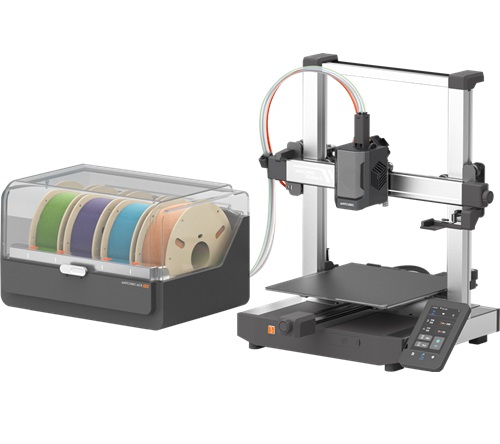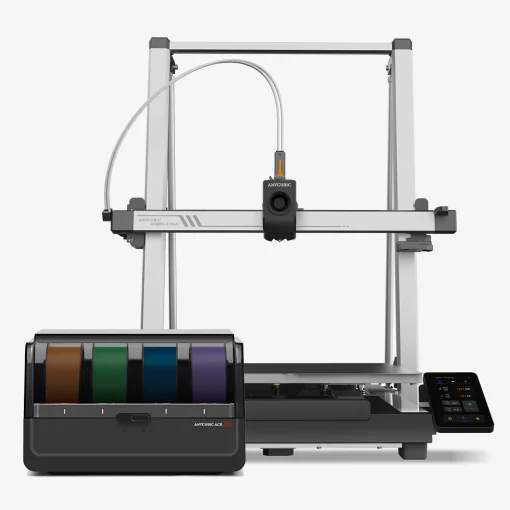Compare Kobra 3 Combo vs Kobra 3 Max Combo
Comparison between the best 3D printers
Choose the best 3D printer at the best price. The cheapest 3D printers are here.
Buy a 3D printer here with 3D Fila.
 |
 |
|
| Model | Kobra 3 Combo[BUY Kobra 3 Combo] |
Kobra 3 Max Combo |
| Printing Material | Filament | Filament |
| Buy Filament for Anycubic Kobra 3 Combo | Buy Filament forAnycubic Kobra 3 Max Combo | |
| Estimated price | $349,00 | $699,00 |
| Manufacturer | Anycubic | Anycubic |
| Release Year | 2024 | 2025 |
| Print Volume [mm] | 250x250x260 | 420x420x500 |
| Printer Size [mm] | 452x504x483 | 640x753x706 |
| Weight [kg] | 9,2 | 23,6 |
| Power Loss Recovery | YES | YES |
| Enclosed printer | NO | NO |
| Bed Leveling | Automatic | Automatic |
| Filament End Sensor | YES | YES |
| Bed type | Heated | Heated |
| Power supply system | Direct Drive | Bowden |
| Standard nozzle | 0,4 | 0,4 |
| Maximum Nozzle Temperature [°C] | 300 | 300 |
| Maximum Bed Temperature [°C] | 110 | 90 |
| Maximum printing speed [mm/s] | 600 | 600 |
| Filament holder | YES | YES |
| Camera for supervision | NO | NO |
| Recommended filaments | PLA, PETG, ABS, PP, HIPS | PLA, PETG, TPU |
| Recommended slicers | Anycubic Slicer, Cura, Orca Slicer | Anycubic Slicer, Cura, Orca Slicer |
| Maximum Resolution [mm] | 0,1 | 0,01 |
| Processor | 32 bits | |
| Display | Touchscreen 4,3'' | Touchscreen 4,3'' |
| Power Supply | 400 W | 800 W |
| Connectivity | USB, Wi-Fi, Cloud | USB, Wifi |
| Operating systems | Windows, Linux, Macbook | Windows, Mac, Linux |
| Date of registration in the system | 2024-06-27 | 2025-03-06 |
| Release date | 2024 | 2025 |
| Extra features | The Anycubic Kobra 3 Combo offers advanced features, including multi-filament printing with the ACE (Anycubic Color Engine) system, allowing for quick switching of up to four filaments. It features automatic bed leveling, nozzle clogging detection, and integrated filament drying during printing. The printer supports technical materials such as ABS, ASA, Nylon, and PC, thanks to the hotend that reaches 300°C and the heated bed up to 110°C. In addition, it has a 4.3-inch touchscreen and compatibility with various slicers such as Anycubic Slicer, Cura, and Orca Slicer. | The Anycubic Kobra 3 Max Combo combines high-speed and multicolor printing with up to 8 colors. It features automatic leveling, quick filament switching, clog and entanglement detection, and AI to prevent print failures. Its 800W hotbed heats up quickly, while 10,000mm/s² acceleration ensures efficiency. App and Wi-Fi control, print recovery, and video monitoring enhance the user experience. |
| Support for multiple colors and materials (AMS and CFS) | YES | YES |
Notes * |
||
| Cost-benefit | 8 / 10 | 7 / 10 |
| Hardware | 4.5 / 10 | 6 / 10 |
| Tela | . | . |
| Print volume | 4 / 10 | 4 / 10 |
| Performance | 5 / 10 | 5 / 10 |
| [BUY Kobra 3 Combo] |
Conclusion |
| In comparing the Anycubic Kobra 3 Combo and the Kobra 3 Max Combo, several factors emerge that highlight their respective strengths and weaknesses tailored toward different user needs. The Kobra 3 Combo offers a more budget-friendly option without compromising essential features. It has a commendable build volume and supports a variety of filaments, making it suitable for most hobbyist projects. Its innovative multi-filament printing system, operating at a maximum nozzle temperature of 300°C and a bed temperature of 110°C, places it well within the range of versatility. On the other hand, the Kobra 3 Max Combo stands out with its significantly larger print volume, accommodating more ambitious projects. It supports an advanced multi-color printing system with capabilities for up to eight colors, which can be particularly appealing for professionals and advanced hobbyists seeking detailed and diverse outputs. The enhanced power supply and features designed to optimize print reliability, such as AI for failure prevention and video monitoring, elevate the user experience. While the Kobra 3 Combo scores slightly higher in cost-benefit ratio, suggesting great value for its price, the Kobra 3 Max Combo justifies its higher price point with expanded capabilities and features. Ultimately, the choice between the two depends largely on the user's specific needs—whether prioritizing affordability and essential features or opting for larger volume and advanced functionality. |

